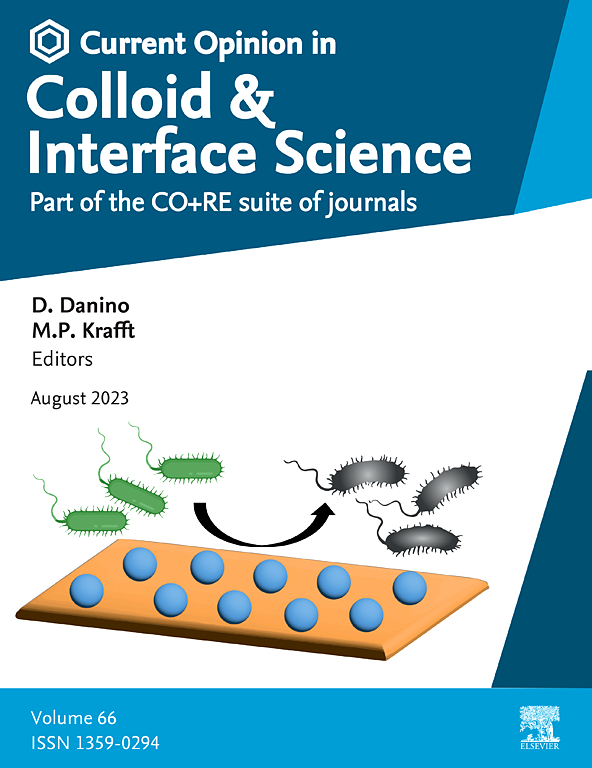Plant protein adsorption at oil–water interfaces: A mapping review using alternate subphase tensiometry
IF 7
2区 化学
Q1 CHEMISTRY, PHYSICAL
Current Opinion in Colloid & Interface Science
Pub Date : 2025-04-17
DOI:10.1016/j.cocis.2025.101920
引用次数: 0
Abstract
Plant proteins are rapidly emerging as functional food ingredients as a more sustainable and ethical alternative to established animal proteins, e.g., for the interfacial stabilization of emulsions and foams. To date, there is a large knowledge gap between plant and animal proteins, and it is often difficult to predict the interfacial performance of novel plant proteins, their individual fractions, and behavior as a function of processing conditions. Here, we introduce alternate subphase tensiometry (AST) as a novel method to map literature data on interfacial tension reduction of novel protein sources. We collected, compiled, and reanalyzed interfacial tension literature data from pea, soy, chickpea, lentil, faba bean, wheat, and microalgae protein. AST allows standardized plotting of literature data in uniform graphs, providing a rapid overview of the present data and pinpointing current gaps. Furthermore, grouped data can be readily singled out to identify promising protein fractions and effects of processing conditions such as pH, ionic strength, or pretreatments. Hence, AST is a powerful tool to summarize the existing data landscape, identify research gaps and particularly promising protein fractions, and ultimately predict the interfacial performance of plant proteins for interfacial stabilization of emulsions and foams.

植物蛋白在油水界面的吸附:利用交替亚相张力测定法的制图回顾
植物蛋白正迅速成为功能性食品成分,作为一种更可持续和更合乎道德的替代已建立的动物蛋白,例如用于乳液和泡沫的界面稳定。迄今为止,植物蛋白和动物蛋白之间存在很大的知识差距,并且通常很难预测新型植物蛋白的界面性能,它们的单个组分以及作为加工条件的函数的行为。在这里,我们介绍了交替亚相张力测定法(AST)作为一种新的方法来绘制新的蛋白质来源的界面张力降低的文献数据。我们收集、整理并重新分析了来自豌豆、大豆、鹰嘴豆、扁豆、蚕豆、小麦和微藻蛋白的界面张力文献数据。AST允许在统一的图形中对文献数据进行标准化绘图,提供对当前数据的快速概述并精确指出当前差距。此外,分组数据可以很容易地挑选出来,以确定有希望的蛋白质组分和加工条件的影响,如pH值、离子强度或预处理。因此,AST是一个强大的工具,可以总结现有的数据景观,确定研究空白和特别有前途的蛋白质组分,并最终预测植物蛋白在乳液和泡沫界面稳定中的界面性能。
本文章由计算机程序翻译,如有差异,请以英文原文为准。
求助全文
约1分钟内获得全文
求助全文
来源期刊
CiteScore
16.50
自引率
1.10%
发文量
74
审稿时长
11.3 weeks
期刊介绍:
Current Opinion in Colloid and Interface Science (COCIS) is an international journal that focuses on the molecular and nanoscopic aspects of colloidal systems and interfaces in various scientific and technological fields. These include materials science, biologically-relevant systems, energy and environmental technologies, and industrial applications.
Unlike primary journals, COCIS primarily serves as a guide for researchers, helping them navigate through the vast landscape of recently published literature. It critically analyzes the state of the art, identifies bottlenecks and unsolved issues, and proposes future developments.
Moreover, COCIS emphasizes certain areas and papers that are considered particularly interesting and significant by the Editors and Section Editors. Its goal is to provide valuable insights and updates to the research community in these specialized areas.

 求助内容:
求助内容: 应助结果提醒方式:
应助结果提醒方式:


